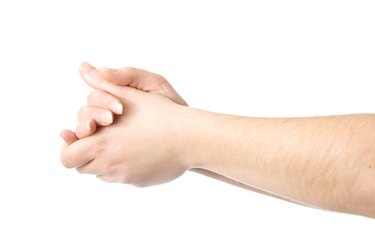
If you often have cold hands or your fingers get numb and tingly, you could have poor circulation in your arms. There are several common causes, and treatment depends on the cause. But there are usually some lifestyle changes and other things you can do to improve circulation naturally.
"Poor circulation in your arms can be as simple as prolonged sitting with your elbows leaning against a hard surface for a long time. It can also be caused by peripheral arterial disease," says Houston-based John P. Higgins, MD, professor of cardiovascular medicine at McGovern Medical School, UTHealth, and director of exercise physiology, Memorial Hermann Institute for Sports Medicine and Human Performance.
Video of the Day
Video of the Day
Read more: Exercises to Increase Blood Circulation
Whole-Body Approaches to Improve Circulation
"You can improve circulation by doing things that make your arteries more flexible and promote new blood vessel growth," Dr. Higgins says. "Preventing blood clotting, delivering nutrients to cells, decreasing inflammation and preventing blocked arteries are all associated with improved vascular function."
Dr. Higgins suggests these tips to improve blood circulation naturally:
- Exercise and get active.
- Learn to reduce stress.
- Lower your cholesterol with a healthy diet.
- Avoid trans fats and saturated fats.
- Eat more lean meat, fruits, vegetables, nuts and dark chocolate.
- Lower blood pressure with a low-salt diet and exercise.
- Get at least seven
to nine hours of sleep each night.
- Reduce blood sugar by cutting back on highly processed sugary snacks.
- Stop smoking and avoid secondhand smoke.
The Best Exercises to Try
The best exercise for improving circulation is cardio or aerobic exercise, according to Johns Hopkins Medicine. Try to get 30 minutes at least five days a week. Examples include walking briskly, running, swimming, cycling, jumping rope or playing tennis.
The Mayo Clinic adds these specific simple exercises that you can try to boost circulation:
- Wiggle your fingers and toes.
- Make wide windmill circles with your arms.
Massage and Warm Water Can Also Help
The Mayo Clinic also suggests these handy tips (pun intended):
- Massage your hands.
- Place your hands under your armpits.
- Run your hands under warm water.
Alternative Approaches
You may also wish to ask your doctor about these alternative approaches that could improve circulation naturally, per the Mayo Clinic:
- Fish oil supplements
- Ginkgo supplements
- Acupuncture
- Biofeedback
When to Seek Help
According to the American Society for Surgery of the Hand (ASSH), poor circulation in your arms that does not go away or keeps coming back is probably due to a circulation disease. This usually occurs when one of the two main arteries of your arm, the radial or the ulnar artery, is narrowed (vasoconstriction), blocked (vaso-occlusion) or diseased.
Peripheral arterial disease is poor circulation due to a buildup of plaque inside arteries. Although this disease is more common in the legs, it can also affect blood flow in the arms, according to the Centers for Disease Control and Prevention.
Other possible causes of poor arm circulation, according to the Mayo Clinic, include:
- Anemia
- Diabetes
- Extreme cold (such as frostbite)
- Lupus
- Buerger's disease
- Scleroderma
Residing in a cold climate could also affect your circulation. Raynaud's disease can cause poor circulation and affects more women than men, according to the Mayo Clinic. While typically not serious, it can affect your quality of life. Symptoms include:
- Changes in skin color of your hands due to cold or emotional stress
- Numb fingers
- Tingling or stinging pain
- Improvement of symptoms when you are warm or relaxed
Call your doctor if you experience any of these symptoms, per the ASSH:
- Cold hands even when it's not cold outside
- Pain in your fingers when your hands are cold
- Needing to wear gloves inside or when handling frozen food
- Hands that turn color, which could be white, red or blue, especially in the cold
- Poor healing of finger cuts
- John P. Higgins, MD, MBA (Hons), MPHIL, FACC, FACP, FAHA, FACSM, FASNC, FSGC; professor of cardiovascular medicine, McGovern Medical School, UTHealth; senior cardiologist, Lyndon B. Johnson General Hospital; director of exercise physiology, Memorial Hermann Institute for Sports Medicine and Human Performance; sports cardiologist, Houston Rockets, Rice Athletics; Houston, Texas
- American Society for Surgery of the Hand: “Cold Hands”
- Centers for Disease Control and Prevention: “Peripheral Arterial Disease (PAD)”
- Mayo Clinic: “Cold Hands”
- Mayo Clinic: “Raynaud’s Disease”
- Johns Hopkins Medicine: “3 Kinds of Exercise That Boost Heart Health”
Is this an emergency? If you are experiencing serious medical symptoms, please see the National Library of Medicine’s list of signs you need emergency medical attention or call 911.